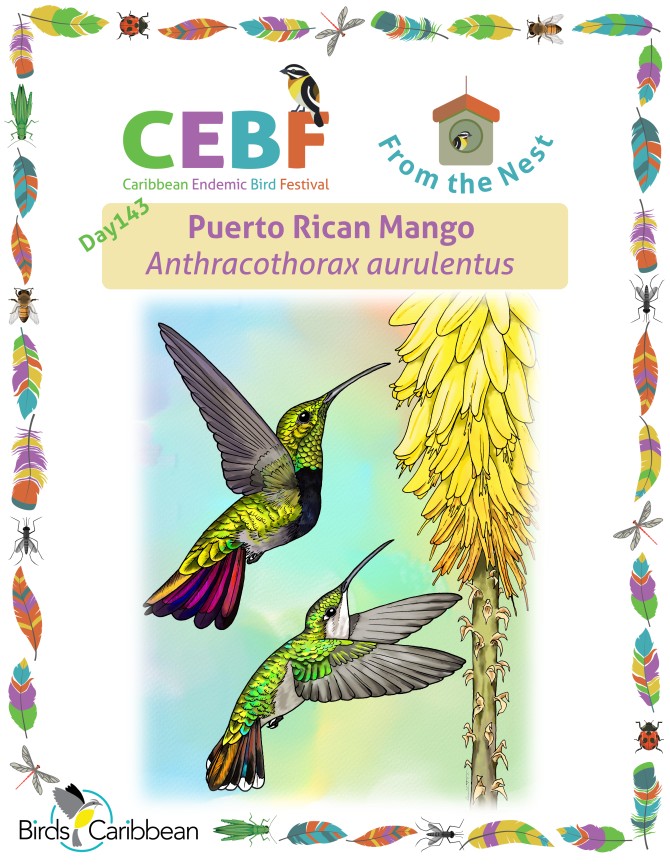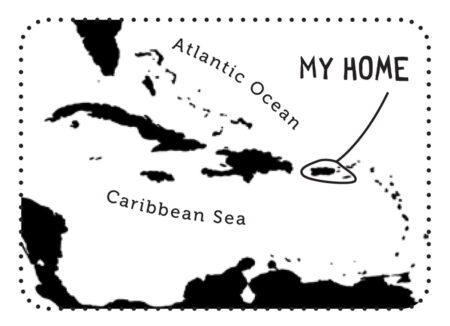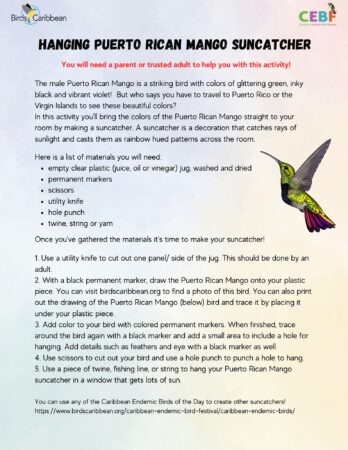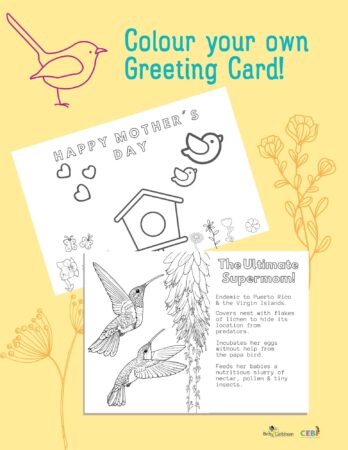Celebrate the Caribbean Endemic Bird Festival (CEBF) with us! Our theme in 2024 is “Protect Insects, Protect Birds”—highlighting the importance of protecting insects for birds and our environment. Have fun learning about a new endemic bird every day. We have colouring pages, puzzles, activities, and more. Download for free and enjoy learning about and celebrating nature!
Endemic Bird of the Day: Puerto Rican Mango
The Caribbean is alluring to many people with its tropical climate, picturesque landscapes that look like they’ve been pulled straight from paradise, and of course—mangos! But we’re not talking about the delicious tropical fruit—we’re talking about the dazzling hummingbirds that belong to the Anthracothorax genus. We think you’ll agree that they do nourish the soul and spirit, just like our region’s beloved fruit. There are four endemic mangos in the Caribbean, one of which is the Puerto Rican Mango (Anthracothorax aurulentus). This medium-sized hummingbird has a long, decurved bill and that adds a bit of green glimmer to Puerto Rico and the Virgin Islands.
In poor light, male Puerto Rican Mangos can appear all-dark, but when well illuminated, those seemingly unassuming colours transform—allowing us to witness a spectacular special-effects polychromatic show! Getting a glimpse of this magic makes it apparent why the local names for the species are “colibrí dorado” (golden hummingbird) and “zumbador dorado” (golden buzzer). The upperparts and throat gleam bright greenish-yellow, and chest deep indigo with green sides. The lower breast and belly are paler than the chest, and the lower belly is usually white. The tail feathers are a moody maroon-purple with black edging. Females have the same iridescent green upperparts, but drab white underparts with gray flanks. When their tails are folded, the outer feathers usually appear coppery or greenish; when fanned, these feathers show large rusty patches near the base with broad white tips.
Not too long ago, the Puerto Rican Mango and Hispaniolan Mango were considered the same species—then called the Antillean Mango. In 2022, the split was made based on plumage and morphometric (size and shape) differences observed in museum specimens. The male Hispaniolan Mango (Anthracothorax dominicus) has a shimmering green throat and entirely velvet-black underparts, and the female has a purplish tail base.
The species is widespread throughout Puerto Rico where you can spot them in dry forests, forest clearings, scrub, shade coffee plantations, and suburban gardens. Historically it was abundant on Vieques island but is now considered rare there as the last reported sighting was in 1994. The decline of the mango on the islands coincided with both the arrival of the Green-throated Carib, another Caribbean endemic, and the conversion of forest to more human-disturbed habitats—which the carib thrives in but the mango does not. A similar decline occurred on the Virgin Islands where its range is now limited to Virgin Gorda, Anegada, the Beef Islands, Guana Island, and St. Thomas.
If you are from, or visiting, any of these islands, listen for its call—a high-pitched, sharp chip described as “tsick“; or for its song, a high, thin rapid trill or buzz preceded and followed by one or several high pitched “tsit” notes.
Like other hummingbirds, the Puerto Rican Mango is a sugar addict with an insatiable appetite for nectar! It doesn’t only consume nectar though. It is also skilled at capturing and eating insects, including small wasps, beetles, and flies—all while in the air! Males will however still aggressively defend nectar-rich territories from other nectar feeding birds.
Its breeding season extends throughout the year but peaks from March to July. Mama hummingbirds build a deep cup-shaped nest lining the inside with soft plant fibres whereas the outside is covered with flakes of bark and lichen bound together by spider webs. They incubate the two eggs for approximately 15 days. The nestlings are fed a nutritious mix of nectar and insects that is regurgitated straight into their hungry beaks. After about 25 days they are strong enough to leave the nest to start their own lives.
Fortunately the Puerto Rican Mango is not a threatened species! However, we need to ensure we can enjoy their dazzling displays for years to come by planting native flowers that hummingbirds feed on in our gardens, reducing our use of insecticides (most of which kill both the good and bad insects), and supporting local environmental organizations with their reforestation initiatives.
Learn more about this species, including its range, photos, and calls here. Great news! If you’re in the Caribbean, thanks to BirdsCaribbean, you have free access to Birds of the World and you can find out even more in the full species account of this bird!
Thanks to Arnaldo Toledo for the illustration and Aliya Hosein and Adrianne Tossas for the text!
Colour in the Puerto Rican Mango
Download our West Indies Endemic Bird colouring page. Use the photos below as your guide, or you can look up pictures of the bird online or in a bird field guide if you have one. Share your coloured-in page with us by posting it online and tagging us @BirdsCaribbean #CEBFfromthenest
Listen to the song of the Puerto Rican Mango
The song of the Puerto Rican Mango is made up of high-pitched, thin rapid trills and buzzing notes, often with high pitched “tsit” calls at the start and end.
Puzzle of the Day
Click on the image below to do the puzzle. You can make the puzzle as easy or as hard as you like – for example, 6, 8, or 12 pieces for young children, all the way up to 1,024 pieces for those that are up for a challenge!
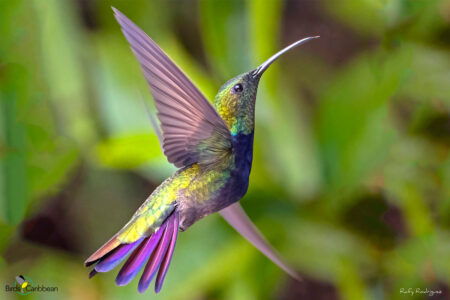
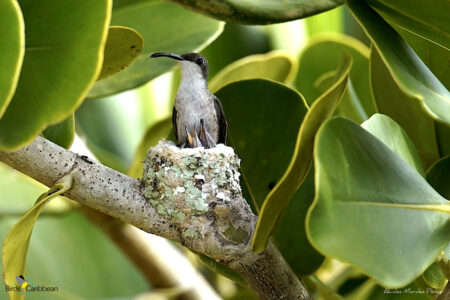
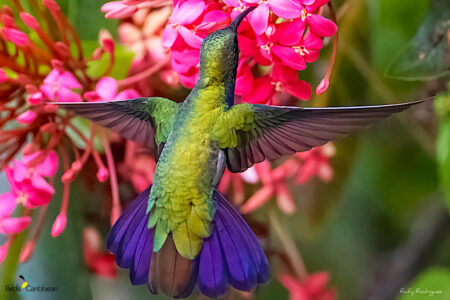
Enjoy these beautiful photos of the Puerto Rican Mango!
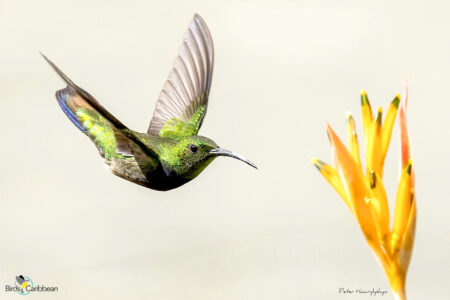
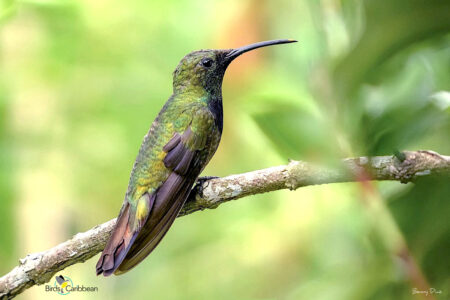
Activity of the Day
FOR KIDS : The Puerto Rican Mango is a striking bird with vivid shining colours of glittering green, inky black and vibrant violet! But who says you have to travel to Puerto Rico or the Virgin Islands to see these beautiful colours? In this activity you’ll make a suncatcher—a decoration that catches rays of sunlight and casts them as rainbow hued patterns across the room! You might want to make this beautiful suncatcher as a gift for Mother’s Day!
Here is a list of materials you will need:
- empty clear plastic milk jug, washed and dried
- permanent markers
- scissors
- utility Knife
- hole punch
- twine, string or yarn
You can download full instructions here including a bird template for you to use. This activity involves using a knife and scissors.
Make sure you have an adult to help you with the cutting.
Let’s celebrate moms AND endemic birds!
Mother’s Day is this weekend on May 12th and we’ve got you covered. We have an endemic bird-themed Mother’s Day Cards to download and colour. This is a fun activity for people of all ages to celebrate the mother figure in their life!
Please download and print our card template (letter size will work best but A4 will be ok too). It’s best to use card stock, but regular printer paper will do just fine. Once printed, fold in half horizontally (so the short sides touch) and write your own special message on the inside! Don’t forget to colour in the pictures on the front and on the back. Or if you are feeling really creative be inspired by one our featured birds and draw your own greeting card!
FOR KIDS AND ADULTS : Enjoy this video of a Puerto Rican Mango at its nest in the wild!
Read all about how the Antillean Mango got split into two new species back in 2022! One of these was the Puerto Rican Mango, but do you know which other island also got a ‘new’ species of hummingbird from this split?

